Kenneth L. Gentry Jr.'s Blog, page 107
September 11, 2015
DISPENSATIONALISM DISTORTS CHRIST’S RULE
PMT 2015-109 by Kenneth L. Gentry, Jr. 
In this and the next few blog articles, I will be highlighting three types of distortions involved in classic dispensationalism, the most wildly popular eschatological position in the modern evangelical market. These distortions are harmful to a balanced Christian worldview. In this brief series, I have chosen to cover classic dispensational errors in the areas of christology, redemptive history, and contemporary historical progress. There are, of course, many other areas that I could consider.
Before I begin considering these, it should be understood that, as in any system, there will be some internal disagreements among its adherents. The aspects I have chosen for scrutiny are broadly popular, even if some of the details of the following features are debated by dispensational theologians. I would also note that I will not be dealing with the latest variety of dispensationalism, “progressive dispensationalism.” This is because I am more concerned with the enormous influence of the older form which lies behind many multi-million selling books found in Christian bookstores everywhere. It’s influence is as large as it sales are enormous.
Classic dispensationalism denies the contemporary presence of Christ’s kingdom, despite the clear teaching of Scripture. Thomas Ice writes that: “Whatever dynamic God has given believers today does not mean that the Messianic kingdom is here. We see it as totally future.” [1]
Three Views on the Millennium and Beyond
(ed. by Darrell Bock)
Presents three views on the millennium: progressive dispensationalist, amillennialist, and reconstructionist postmillennialist viewpoints. Includes separate responses to each view.
See more study materials at: www.KennethGentry.com
The dispensational view requires Christ’s physical presence or earth to rule over His kingdom. Dispensationalists often say, “You canoed have the kingdom present without the presence of the king.” Of course, an immediate problem with this statement is that Satan has an evil kingdom present (Matt. 12:26; John 12:31; 14:30; 16:11), even though he is only spiritually present (Eph. 2:2; 2 Cor. 4:4; Eph. 6:12). But a more serious problem is that Christ clearly taught that He established His kingdom when He came to earth. Let us survey some of the evidence.
In Mark 1:14-15, early in His ministry, Christ said: “The time is fulfilled, and the kingdom of God is at hand.” Notice that the prophetically decreed time had come; the kingdom was declared near at hand -not 2000 (or more!) years away. A little later in His ministry, as he exercised power over Satan, the Lord noted: “if I cast out devils by the Spirit of God, then the kingdom of God is come unto you” (Matt. 12:28).
Christ even prophesied that its coming with great power would be witnessed by His hearers: “And he said unto them, Verily I say unto you, That there be some of them that stand here, which shall not taste of death, till they have seen the kingdom of God come with power” (Mark 9:1).[2] There seems no way around the fact that some that literally stood in Jesus’ presence would live (“not taste death’) until that time. Although by the very expression, it is implied that some would, in fact, taste death before that event. Consequently, Christ teaches that the kingdom’s coming “with power” would occur in that generation, even though it would be somewhat later than when Jesus spoke (and, hence, not the Transfiguration of only six days later).
Thus, in Colossians 1:13 Paul writes of our present salvation: “He hath delivered us from the power of darkness, and hath translated us into the kingdom of His dear Son.” John agrees in Revelation 1:6, 9: “And He hath made us kings and priests unto God and His Father. . . I John, who also am your brother, and companion in the tribulation, and in the kingdom and patience of Jesus Christ.” In tact, we are now ruling with Christ, for Paul says in Ephesians 2:6: He “hath raised us up together, and made us sit  together in heavenly places in Christ Jesus” (cp. Rom. 6:5; 8:17: Col. 2:13; 3:1-3; Rev. 20:4).
together in heavenly places in Christ Jesus” (cp. Rom. 6:5; 8:17: Col. 2:13; 3:1-3; Rev. 20:4).
Dispensationalism
(by Keith L. Mathison)
An important critical evaluation of dispensationalism from a Reformed perspective.
See more study materials at: www.KennethGentry.com
Dispensationalism distorts Christ’s teaching about the coming of His kingdom, despite the clarity of His teaching on the matter. In other words, a major reason for Christ’s first coming was that he might be gloriously enthroned as Messianic king (Isa. 9:6,7; Luke 24:26; John 12:23; 17:5; 18:37; Acts 2:30-34; 1 Pet. 1:1 1), which understanding is lost in classic dispensationalism!
In my next article I will conclude the study of the Christological distortions in dispensationalism.
Footnotes
1. H. Wayne House and Thomas D. Ice, Dominion Theology: Blessing or Curse? (Portland, OR: Multnomah, 1988), 220.
2. There seems to be a distinction necessary here between the kingdom’s coming (which in Luke 17:20-21 is subtle and present, see later discussion) and the kingdom’s coming “with power” (which comes in the destruction of the temple in a very dramatic way in the near future from Christ’s perspective).








September 9, 2015
REVELATION AND DOUBLE FULFILLMENT
PMT 2015-108 by Kenneth L. Gentry, Jr.
I frequently have folks respond to my presentation of the preterist argument for Revelation in an unusual way. They see the strength of the preterist analysis of Revelation. They recognize that it is difficult to get around Revelation’s opening and closely comments regarding the temporal nearness of its prophecies. After all, Revelation 1:1 states rather clearly:
The Revelation of Jesus Christ, which God gave Him to show to His bond-servants, the things which must soon take place.
And Revelation 22:6 closes the book on the same note:
These words are faithful and true”; and the Lord, the God of the spirits of the prophets, sent His angel to show to His bond-servants the things which must soon take place.
Since these statements are so clear and compelling, some believers attempt an end-run around them. They agree that Revelation does in fact point to events that were to occur in John’s lifetime. But then they argue that these events can have double-fulfillment, so that they occur originally in the first century, but will occur again toward the end. For instance, Marvin Pate holds that Revelation “does not imply that Nero filled the complete expectation of the coming antichrist, but, as a precursor to such, he is certainly a good starting place.”[1]
Before Jerusalem Fell
(by Ken Gentry)
Doctoral dissertation defending a pre-AD 70 date for Revelation’s writing. Thoroughly covers internal evidence from Revelation, external evidence from history, and objections to the early date by scholars.
See more study materials at: www.KennethGentry.com
Three difficulties plague this type of response:
Lack of Exegetical Warrant
First, there is no exegetical warrant for double-fulfillment in Revelation. The statement is pure theological assertion. What is more, this approach not only empties John’s express declarations of meaning (“these things must shortly come to pass“), but it contravenes a specific angelic directive contrasting John’s responsibility to Daniel’s. An angel commands Daniel to “seal up” his prophecy for later times (Dan. 12:4), but commands John (who lives in “the last hour,” 1 John 2:18) to “not seal the words of the prophecy of this book, for the time is at hand” (Rev. 22:10).
Stretching of Intellectual Credulity
Second, the double-fulfillment argument requires us to believe that the many specific events, things, and personages of Revelation will appear repeatedly on the scene of earth history. In the same order? In the same geographic regions? With continual groupings of 144,000 being sealed? With constant beasts designated by the same number 666? On and on I could go. For example, Pate suggests that “the signs of the times began with Jesus and his generation,” and history witnesses “the coming intensification and culmination of those signs of the times” which begin in the first century.[2] Such a position seems to stretch credulity to the breaking point.
The already/not yet theological principle, though valid and widely accepted by evangelicals, cannot govern whole, vast, complex works such as Revelation. The already/not yet principle applies to unitary, simple constructs: the kingdom, salvation, new creation, and so forth. The principle snaps apart when we stretch it over so vast a work as Revelation. Furthermore, how can this principle explain the simultaneous operation in one book of such allegedly global themes operating as judgment (Rev. 6-19) and blessing (Rev. 20-22)? Pate’s use of this principle to explain Revelation seems more hopeful than helpful.[3]
Confusing Interpretation and Application
Third, this approach not only denies what John expressly affirms, but confuses principial application with original interpretation. That is, even were the events of Revelation repeated, that would not diminish the fact of their direct first century historical fulfillment — with all its pregnant meaning in that unique era which effects the closing of the sacrificial system, the setting aside of Israel, and the universalizing of the true faith. For instance, Exodus-like events occurring after the Mosaic Exodus do not remove the redemptive-historical significance of that original historical episode. Pate specifically notes the mark of the Beast “can be understood as pointing a guilty finger at those Jews in the first century.”[4] Why, then, should we look for further fulfillments beyond this most relevant first century one?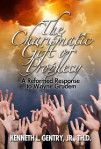
Charismatic Gift of Prophecy
(by Kenneth Gentry)
A rebuttal to charismatic arguments for the gift of prophecy continuing in the church today.
See more study materials at: www.KennethGentry.com
According to John, then, the prophetic events are “soon” (Rev. 1:1) and “at hand” (Rev. 1:3), so that his original audience must “hold fast” (Rev. 2:25; 3:11), waiting only “a little while longer” (Rev. 6:10). “I am coming soon. Hold on to what you have, so that no one will take your crown” (Rev. 3:11). The modern student of prophecy must not let his presupposed theological scheme or predetermined interpretive methodology blunt these forceful assertions.

Endnotes
C. Marvin Pate and Calvin B. Haines, Jr., Doomsday Delusions: What’s Wrong with Predictions About the End of the World (Downer’s Grove, Ill.: Inter-varsity, 1995),43-44.
Pate and Haines, 36 (cp. 44, 57), 148-149. Emphasis added.
Pate and Haines, 148-155.
Pate and Haines, 53.








September 8, 2015
POSTMILLENNIALISM AND SUFFERING
PMT 2015-106 by Kenneth L. Gentry, Jr.
Postmillennialism is distinguished from the pessimistic eschatologies of amillennialism, premillennialism, and dispensationalism as being optimistic. In the long run, mind you. Nevertheless, the Bible seems to develop a suffering-church motif.
Oftentimes the (historically) pessimistic eschatologies employ the suffering-church motif against the optimistic hope of postmillennialism. But the postmillennial system can handle the slings and arrows of outrageous fortune and can take arms against the sea of troubles. Let us see how postmillennialism recognizes the fact of suffering and yet remains optimistic regarding the global prospects of the gospel.
Postmillennialists can affirm suffering-with-Christ as a basic element of our Christian experience even up to the end — if we carefully reflect on the biblical requirements of the suffering argument.
We suffer as fallen creatures enduring physical weakness in this age
In Ro 8:17 Paul argues that if we are his children, then we are “heirs also, heirs of God and fellow heirs with Christ, if indeed we suffer with him in order that we may also be glorified with Him.” He explains this suffering by teaching us that “the creation was subjected to futility, not of its own will, but because of him who subjected it, in hope” and that “the whole creation groans and suffers the pains of childbirth together until now” (8:20, 22).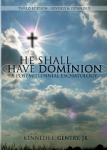
He Shall Have Dominion
(paperback by Kenneth Gentry)
A classic, thorough explanation and defense of postmillennialism (600 pages)
See more study materials at: www.KennethGentry.com
Paul is explaining why believers, though “free from the law of sin and of death” (8:2), still suffer “the whole range of the weakness which characterize us in this life” (Murray, Romans, 1:311), “the whole gamut of suffering, including things such as illness, bereavement, hunger, financial reverses, and death itself” (Moo, Romans, 511). How can this be? Our glory awaits the future “redemption” of the body (8:23) by the Spirit of God (8:11). We are even too weak to pray as we ought, so the Spirit (who resurrects) intercedes for us (8:26–27).
Thus, Paul laments his being in a “mortal body” (Ro 6:12; 8:11), a body subject to corruption and decay (2Co 4:16); he declares that ultimately this “mortality” must put on “immortality” (1Co 15:53–57). We suffer in bodies that are mere “earthen vessels” (2Co 4:7), subject to “bodily illness” (Gal 4:13), “frequent infirmities” (1Ti 5:23), “sickness to the point of death” (Php 1:27). Elders in the church must assist in prayers for healing (Jas 5:17) because sickness is painful and limiting (Gal 4:13), “to the point of death” (Php 1:27) and may even cause death and its bereavement (Jn 11:33; Ac 9:36–37).
Fowler White urges us to understand that “the relationship between the church’s victory and suffering in Romans 8 reflects a theologically fundamental consideration” (White, “Agony, Irony, and Victory,” WTJ, 167). But when we properly analyze the suffering argument, postmillennialists are not confronted with an insurmountable challenge. For postmillennialism does not expect the elimination of mortality this side of the resurrection. And so these sufferings due to mortality will continue even at the height of the advance of the gospel. These should be borne as Christians, not as “the rest who have no hope” (1Th 4:13; cf. Eph 2:12; Jas 1:2–4; Tit 2:7).
We suffer in a world with the principle of evil present
As regenerate, spiritually (semi-eschatological) resurrected believers, we abhor the sinful tendencies present in ourselves and in others. Paul is torn as he struggles to please God (Ro 7:21–23). He cries out in misery: “Wretched man that I am! Who will set me free from the body of this death?” (Ro 7:24). As Bruce puts it: “Paul himself knows what it means to be torn this way and that by the law of his mind which approves the will of God, and the law of sin and death which pulls the other way. The Christian, in fact, lives in two worlds simultaneously, and so long as this is so he lives in a state of tension” (F. F. Bruce, Romans, 151).
Perilous Times: A Study in Eschatological Evil (by Ken Gentry)
Technical studies on Daniel’s Seventy Weeks, the great tribulation,
Paul’s Man of Sin, and John’s Revelation.
See more study materials at: www.KennethGentry.com
Even at the height of the kingdom’s (postmillennial) advance in the world we will suffer temptation due to “the worry of the world and the deceitfulness of riches” (Mt 13:22). We will always struggle against the “sin which so easily entangles us” (Heb 12:1), the “the lust of the flesh and the lust of the eyes and the boastful pride of life” (1Jn 2:16). Due to our suffering the temptation to sin within, each Christian must follow after Paul, declaring: “I buffet my body and make it my slave” (1Co 9:27; cp. Ro 8:13; Col 3:5).








September 4, 2015
PERSECUTION AND REVIVAL IN INDIA
 PMT 2015-107
PMT 2015-107
An insightful article on the vibrance of resurgent Christianity in Hindu India. Pray for our brothers there. Pray for our faith worldwide. Here is the first portion of the article
Christian Faith Is Growing 7 Years After Hindu Radicals Killed 100 Believers, Destroyed 6,000 Churches in India
By Stoyan Zaimov , Christian Post Reporter
Christians in India marked the seventh anniversary of the Orissa attacks on Monday, praying for close to 100 Christians who were massacred by Hindu extremists who were pressuring them to convert. An Archbishop has said the faith of Orissa’s Christians has grown stronger in the face of persecution.
The Archbishop of Cuttack-Bhubaneswar, His Exc. Mgr. John Barwa SVD, told Fides News Agency that Christians “gather in prayer for the victims, reiterating, all together, our common commitment to promoting peace, justice and hope. The faith of Christians in Orissa has become stronger in the face of persecution.”
The major attacks on August 31, 2008, in Orissa also left close to 56,000 Christians homeless after 300 churches and 6,000 homes were raided and looted. The Hindu mob reportedly organized against Christians who they accused of converting Indians to Christianity.
Bringing Heaven Down to Earth
(by Nathan Bierma)
A Reformed study of heaven. By taking a new look at the biblical picture of heaven,
Nathan Bierma shows readers how heaven can be a relevant, meaningful,
inspiring engine of Christian faith and kingdom service.
See more study materials at: www.KennethGentry.com
Many of the Hindus that had converted to Christianity were from the lowest caste system, known as Dalits, or “Untouchables,” who are often treated as less than human in Indian society. The Dalits see Christianity as a way to escape their low status.
Reports noted that a number of Christian women, including at least one nun, were raped in the attacks.
Another commemoration was held over the weekend in Bangalore, Karnataka state, marking “a dark page in the history of Indian democracy.”
Human rights activist Jagadish G Chandra said the violence in Orissa has forced India’s society to reflect on the persecution of minorities.
“The celebration is an opportunity to reflect on the theme of growing intolerance orchestrated by Hindu extremist groups across the country, and how these ideas have infiltrated the government, police and courts, eroding the values of justice, equality, secularism and citizenship enshrined by the Constitution of India,” Chandra said.
Christians are still waiting for justice over the slayings, however, with only two of the 27 murder trials having been concluded as of yet.
Archbishop John Barwa of Cuttack-Bhubaneswar agreed that the events seven years ago in Orissa have only strengthened the faith of Christians….









September 2, 2015
REVIVAL IN THE MIDDLE EAST?
 PMT 2015-105
PMT 2015-105
I have found a website that has interesting insights into current events relating to the advance of Christianity. That site is: World Revival Network Blog. I have promoted one of its previous articles, and I believe this one is also a timely and helpful one.
It is titled: “The Underground Revival In The Middle-East That Might Just Take Down Islam.” I think you will appreciate it. And I hope you join with me in prayer for this. The article reads:
The churning, tempestuous world looks remarkably different than many imagine. This is undoubtedly true if you’re an average American.
In the darkest corners of the Middle-East there’s a revival beginning that’s unprecedented in the history of world missions. I’ve previously reflected on it here and here, but I wanted to take this amazing story further than before.
I hope that you’ll journey with me as I explore unbelievable developments in the expansion of Christianity in the Middle-East.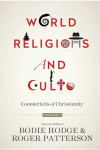
World Religions and Cults (Bodie Hodge, ed.)
This work is helpful for understanding and combating false religions and cults. It deals with the leading false religious beliefs in the world today.
See more study materials at: www.KennethGentry.com
Reliable reports suggest more Muslims have become followers of Jesus over the last two decades than in Islam’s combined 1,500 year history. Based on the accounts of several missiologists, it has been surmised that “more Muslims have committed to follow Christ in the last 10 years than in the last 15 centuries of Islam.”[1] In spite of great difficulty and turmoil, Christianity is unquestionably expanding throughout Islamic world. God is up to something amazing in a region that many have thought was unreachable.
Rosenberg’s Insights Into The Middle-Eastern Revival
Joel Rosenberg, an Evangelical researcher, author, and resident of Israel has documented the recent upsurge of Christianity in the Middle-East. Through first-hand reconnaissance, coupled with reports from Arabic nationals, Rosenberg demonstrates that Christianity is rising rapidly in the world of Islam.
Admittedly some of the following statistics have shifted in the aftermath of the Isis and other violent demonstrations against Christians. Those who follow Jesus have been slaughtered and have experienced severe persecution in this region. Nevertheless, Joel Rosenberg’s observations provide a window into many amazing developments.
Some of the particulars can certainly be debated, but in many of the Mediterranean nations, Christianity is making extraordinary inroads. Though the subsequent conversion figures are impossible to confirm, even in their imprecision, they provide a snapshot of what’s transpiring in the Middle East.
To finish the article click: http://worldrevivalnetwork.blogspot.com/2015/09/the-underground-revival-in-middle-east.html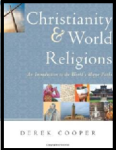
Christianity and the World Religions: An Introduction to the World’s Major Faiths
By Derek CooperCooper. Examines the rival worldviews found in Hinduism, Buddhism, Confucianism and Taoism, Judaism, Islam, and irreligion. He engages these worldviews from a Christian perspective.
See more study materials: www.KennethGentry.com









August 31, 2015
WHAT TEMPLE APPEARS IN REVELATION 11?
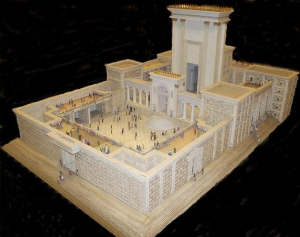 PMT 2015-104 by Kenneth L. Gentry, Jr.
PMT 2015-104 by Kenneth L. Gentry, Jr.
Revelation is an important book in eschatological discussions. The most vigorous Revelation debate in ecclesiastical circles today revolves around the dispute between preterism and futurism. Preterism holds that Revelation was largely fulfilled not long after John wrote it. Futurism holds that it deals largely with events yet to come.
Because of this debate, the identity of the temple in Rev 11 arises as a serious matter. In Revelation 11:1, 2 we read:
And there was given me a reed like unto a rod: and the angel stood, saying, Rise, and measure the temple of God, and the altar, and them that worship therein. But the court which is without the temple leave out, and measure it not; for it is given unto the Gentiles: and the holy city shall they tread under foot forty and two months.
Here we find a Temple standing in a city called “the holy city.” Surely John, a Christian Jew, has in mind historical Jerusalem when he speaks of “the holy city.” This seems necessary in that John is writing scripture and Jerusalem is frequently called the “holy city” in the Bible. For example: Isaiah 48:2; 52:1; Daniel 9:24; Nehemiah 11:1-18; Matthew 4:5; 27:53.
In addition, verse 8 informs us that this is the city where “also our Lord was crucified.” This was historical Jerusalem, according to the clear testimony of Scripture (Luke 9:22; 13:32; 17:11; 19:28). Interestingly, historical Jerusalem is never mentioned by name in Revelation. This may be due to the name “Jerusalem” meaning “city of peace.” In Revelation the meanings of specific names are important to the dramatic imagery. And so it would be inappropriate to apply the name “Jerusalem” to the city upon which woe and destruction are wreaked.
Faith of Our Fathers (DVDs by Ken Gentry)
Explains the point of creeds for those not familiar with their rationale.
Also defends their biblical warrant and practical usefulness.
See more study materials at: www.KennethGentry.com
Now what Temple stood in Jerusalem? Obviously the Jewish Temple ordained of God, wherein the Jewish sacrifices were offered. In the first century it was known as Herod’s Temple. This reference to the Temple must be that historical structure for four reasons:
(1) It was located in Jerusalem, as the text clearly states in verse 8. This can only refer to
the Herodian Temple, which appears over and over again in the New Testament record. It was the very Temple which was even the subject of one of Christ’s longer prophetic discourses (Matt. 23:37-24:2ff).
(2) Revelation 11:1, 2, written by the beloved disciple and hearer of Christ, seems clearly to draw upon Jesus’ statement from the Olivet Discourse. In Luke 21:5-7, the disciples specifically point to the Herodian Temple to inquire of its future; in Revelation 11:1 John specifically speaks of the Temple of God. In Luke 21:6 Jesus tells his disciples that the Temple will soon be destroyed stone by stone. A comparison of Luke 21:24 and Revelation 11:2 strongly suggests that the source of Revelation’s statement is Christ’s word in Luke 21.
• Luke 21:24b: “Jerusalem will be trampled underfoot by the Gentiles until the times of the Gentiles be fulfilled.”
• Revelation 11:2b: “it is given unto the Gentiles: and the holy city shall they tread under foot for forty and two months.”
The two passages speak of the same unique event and even employ virtually identical terms.
(3) According to Revelation 11:2 Jerusalem and the Temple were to be under assault for a period of forty-two months. We know from history that the Jewish War with Rome was formally engaged in Spring, A.D. 67, and was won with the collapse of the Temple in August, A.D. 70. This is a period of forty-two months, which fits the precise measurement of John’s prophecy. Thus, John’s prophecy antedates the outbreak of the Jewish War.
Keys to the Book of Revelation
(DVDs by Ken Gentry)
Provides the necessary keys for opening Revelation to a deeper and clearer understanding.
See more study materials at: www.KennethGentry.com
(4) After the reference to the destruction of the “temple of God” in the “holy city,” John later speaks of a “new Jerusalem” coming down out of heaven, which is called the “holy city” (Rev. 21:2) and which does not need a temple (Rev. 21:22). This new Jerusalem is apparently meant to supplant the old Jerusalem with its temple system. The old order Temple was destroyed in August, A.D. 70.
Thus, while John wrote, the Temple was still standing, awaiting its approaching doom. If John wrote this twenty-five years after the Temple’s fall it would be terribly anachronous. The reference to the Temple is hard architectural evidence that gets us back into an era pre-A.D. 70.









August 28, 2015
IS WORLD VIOLENCE DECLINING?
Postmillennialism’s distinctive element is the conviction that Scripture teaches that the gospel and righteousness will dominate the world for a long period of time before Christ returns. And that this will occur as the Great Commission progresses in its saving work among men. This is also its most doubted and debated point. Each of the other eschatological perspectives predicts the world will get worse until Christ comes to rescue us out of it and effect the Last Judgment.
Postmillennialists have a powerful response to those who see no improvement in world conditions since the first century and the Neronic persecution of Christianity as a minority class. We point out that you cannot disprove postmillennialism on the basis of historical world conditions. Why? Christ has not returned to end history yet, and until he does you cannot demonstrate that he will never pour out his full blessings upon the world. Though it is not a Bible verse, Yogi Berra’s sentiment holds true nonetheless: “It ain’t over til it’s over.”
Greatness of the Great Commission
(by Ken Gentry)
An insightful analysis of the full implications of the great commission.
Impacts postmillennialism as well as the whole Christian worldview.
See more study materials at: www.KennethGentry.com
I would like to point you to an intriguing article regarding world conditions. It seems counterintuitive, but it also appears to be statistically based. I wonder what you think of this World Revival Network Blog article: “Why You Have Been Duped Into Believing the Myth that the World Is Getting Worse and Worse.”
http://worldrevivalnetwork.blogspot.com/2015/08/why-you-have-been-duped-into-believing.html








August 26, 2015
HOLLYWOOD WORLDVIEWS AND POSTMILLENNIALISM
 PMT 2015-102 by Kenneth L. Gentry, Jr.
PMT 2015-102 by Kenneth L. Gentry, Jr.
Millennial views represent an important feature of a Christian worldview. How the world is developing and how it will end necessarily impact one’s worldview thinking. In our day secular humanism is the dominant worldview, crushing out all opposition. But secular humanism is built on air — literally on a chance explosion 13.7 billion years ago. Or perhaps 13.8 billion years ago, depending on who you read.
Postmillennialism is a key component of a truly biblical, and ultimately optimistic worldview. My commitment to postmillennialism is not a side venture in my thinking. It is key to what I believe to be the truth of Scripture. Unfortunately, too many evangelicals are unaware of worldviews and worldview thinking. Because of that “my people are destroyed for lack of knowledge” (Hos. 4:6). And if Christians are not self-consciously aware of the biblical worldview, they will un-self-consciously pick up on a secular worldview by osmosis from our culture.
And one key promoter of secularism and anti-Christianity in our (American) culture is Hollywood. We all enjoy movies. But we do not all understand the (sometimes) hidden worldviews governing any particular movie. Consequently, we inadvertently begin to absorb the Hollywood worldview of the moment. And thus begins the process of societal rot and cultural decline.
Of course, as a postmillennialist I believe that this will ultimately be overcome. But it will not be overcome by a people of God destroyed for lack of knowledge. Rather it will succumb to a people of God who:
“Take up the full armor of God, so that you will be able to resist in the evil day, and having done everything, to stand firm. Stand firm therefore, having girded your loins with truth, and having put on the breastplate of righteousness, and having shod your feet with the preparation of the gospel of peace; in addition to all, taking up the shield of faith with which you will be able to extinguish all the flaming arrows of the evil one. And take the helmet of salvation, and the sword of the Spirit, which is the word of God. With all prayer and petition pray at all times in the Spirit, and with this in view, be on the alert with all perseverance and petition for all the saints.” (Eph 6:13–18)
Great Commission and the Christian Worldview (9 CDs)
by Ken Gentry
In these nine lectures Dr. Gentry demonstrates the world altering consequences of the Great Commission. An important and encouraging study on the biblical foundations of the Christian worldview.
See more study materials at: www.KennethGentry.com
My congregation is sponsoring a “Hollywood Worldviews Seminar” in September to help equip the saints to more effectively engage our culture. If you live in the Greenville, SC, area I would urge you to come and study with us on Friday evening, September 18 and Saturday morning, September 19. This will be an interesting, challenging, and free conference. (Please note: we will not have a nursery.)
If you cannot make it to Greenville, I recommend that you contact Brian Godawa to discuss having one of these seminars at your church. Check out his seminar page on his website: http://www.godawa.com/Speaking/HWSeminarBrochure.pdf
We will win the victory in history, but not by sitting on the sidelines, thinking very little while grinning a lot.
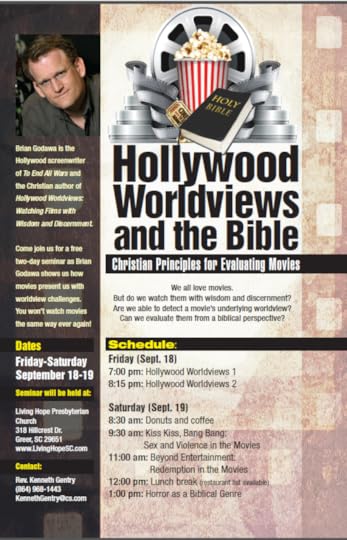








August 24, 2015
REVELATION’S DIFFICULTY
 PMT 2015-101 by Kenneth L. Gentry, Jr.
PMT 2015-101 by Kenneth L. Gentry, Jr.
Evangelical laymen love to hear about the book of Revelation. Unfortunately, they tend to approach it as if it were a child’s toy. Many of contemporary dispensationalism’s best-sellers focus on Revelation. In a childish, unstudied way.
We must recognize that even the trained, diligent scholar must approach Revelation with extreme caution, humbly recognizing that he is opening a book that has perplexed the finest minds and confounded the most godly saints throughout Christian history.
Gaius of Rome (d. 296) laments that “having formed an idea of it as a composition exceeding my capacity of understanding, I regard it as containing a kind of hidden and wonderful intelligence on the several subjects which come under it. For though I cannot comprehend it, I still suspect that there is some deeper sense underlying the words. And I do not measure and judge its expressions by the standard of my own reason, but, making more allowance for faith, I have simply regarded them as too lofty for my comprehension; and I do not forthwith reject what I do not understand, but I am only the more filled with wonder at it, in that I have not been able to discern its import” (Dion., Works 1:1:3).
Eusebius (AD ca. 260–340), the father of church history, notes that many declare it “unintelligible and illogical, and its title false” for it is not “an apocalypse (unveiling), since it is veiled by its heavy, thick curtain of unintelligibility” (Eccl. Hist. 7:25:1, 2). Cyril of Jerusalem (AD 315–86) forbade its public or private reading (Fiorenza 1991: 6). The great Latin church father Jerome (AD 340–420) laments in Epistle 53:8 that it contains “as many mysteries as it does words.” Methodius (d. AD 311) in his Symposium 8:9 mentions “the greatness of the mysteries of the text.”
Navigating the Book of Revelation (by Ken Gentry)
Technical studies on key issues in Revelation, including the seven-sealed scroll, the cast out temple, Jewish persecution of Christianity, the Babylonian Harlot, and more.
See more study materials at: www.KennethGentry.com
Martin Luther (1483–1546), the famed Reformer and untiring interpreter of Scripture, originally rejects Rev as non-canonical, complaining, “My Spirit cannot adapt itself to the book.” In his German translation of the Bible, he complains in the preface to Rev that the book is “neither apostolic nor prophetic.” Fellow Reformer Ulrich Zwingli (1484–1531) refuses to take a doctrinal proof-text from Rev. In his Bern disputation he states: “I do not accept the witness of Revelation because it is not a biblical book.” Even John Calvin (1509–64) omits Rev from his prodigious commentary on the Bible — although he omits other books as well (2 John and 3 John).
John Wesley (1703–91) writes: “It is scarce possible for any that either love or fear God not to feel their hearts extremely affected in seriously reading either the beginning or the latter part of the Revelation. These, it is evident, we cannot consider too much; but the intermediate parts I did not study at all for many years; as utterly despairing of understanding them, after the fruitless attempts of so many wise and good men: and perhaps I should have lived and died in this sentiment, had I not seen the works of the great Bengelius. But these revived my hopes of understanding even the prophecies of this book; at least many of them in some good degree: for perhaps some will not be opened but in eternity.”
Adam Clarke (1762–1832): “I do not understand the book; and I am satisfied that no one who has written on the subject knows anything more of it than myself.”
Book of Revelation Made Easy
(by Ken Gentry)
Helpful introduction to Revelation presenting keys for interpreting.
Also provides studies of basic issues in Revelation’s story-line.|
See more study materials at: www.KennethGentry.com
R. H. Charles (1855–1931), in his ground-breaking commentary on Rev, states that it took him twenty-five years to complete (1: ix). Elsewhere Charles 1) reminds us that “school after school has essayed its interpretation, and school after school has in turn retired in failure from the task.”
Because of these difficulties, deistic radical Thomas Paine cleverly noted that Rev is “a book of riddles that requires a Revelation to explain it.” Ambrose Bierce bitingly defined “Revelation” in his Devil’s Dictionary: “A famous book in which St. John the Divine concealed all that he knew. The revealing is done by the commentators, who know nothing.” Chesterton captures the sentiment of many in this regard: “Though St. John the Evangelist saw many strange monsters in his vision, he saw no creature so wild as one of his own commentators.” South concurs: “The book called the Revelation, the more it is studied, the less it is understood, as generally either finding a man cracked, or making him so.”
Christians: Be careful with Revelation. It has confounded the minds of the greatest scholars. Sadly today the least scholars are monkeying around with it like it was a ripe banana.









August 21, 2015
REVELATION COMMENTARY PROJECT UPDATE
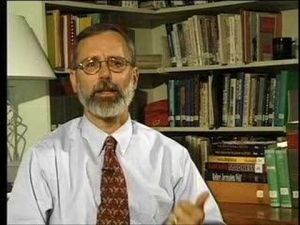 PMT 2015-100 by Kenneth L. Gentry, Jr.
PMT 2015-100 by Kenneth L. Gentry, Jr.
I receive a steady flow of questions regarding my Revelation commentary’s progress towards publication. I will give my blog readers a brief report on this — don’t tell anyone about this. Let’s surprise them. :)
The state of the matter
I spoke with the Tolle Lege editor of my commentary this week. He will finish editing volume 1 this weekend. Then he will send the digital files to me. Once I go over it, make any necessary corrections or additions, and return it to him, he will start work on the final layout. I will be focusing on careful review of the edited manuscript beginning the moment I receive it. I am anxious to get it done!
He noted also that Tolle Lege does have a professional indexer. That means I will only spend a minimal amount of time on indexing. Basically I will get him a key words list to be used for indexing, and he will do the rest. That is a huge relief. Indexing is one of the more tedious tasks in finalizing a book for publication. But it is an essential feature of a book, especially a large, academic one such as this.
The editor said that as it currently stands it looks like each volume could be about 1000 pages. But they are considering making the external dimensions of the book a little larger than standard size. Thus the commentary might not be a standard 6 x 9 format, but perhaps a 7 x 10 format. This will help reduce the number of pages necessary. They don’t want the book too thick, where it wouldn’t be able to lay flat when opened. I am pleased that they are looking into such matters.
The editor still believes he can get volume 2 completed by the end of October. Then the same process would be followed as with volume 1. We are still hoping for a Christmas release, but we will see. Of course, I hope it is Christmas 2015! I can certainly say this work has been as slow as Christmas, such is the labor necessary when working without a research assistant.
You can help!
I invite interested readers of my blog to consider making financial donations towards completing this project. I am now going to have to reserve larger chunks of my time for reading through both volumes to make sure all is well. And I will move immediately into updating and expanding my book Before Jerusalem Fell: Dating the Book of Revelation. It has been used and responded to by a good number of Revelation commentators. But it hasn’t been updated in 15 years. I am being encouraged to get this project done, as well.
Those who donate to this project will be put on a special email list in which you will receive special Revelation studies and research updates. You will also be given special 40% discounts on a large number of my published products (books, DVDs, mp3s).
Please keep all of this in your prayers! God has been good to give me the stamina to engage this project, and to raise up a number of people to help fund it. But it ain’t over til it’s over.
If you are able to give, be aware that you can give to the Revelation Commentary Project as a tax-deductible dontation, if you give through the GoodBirth Ministries website: www.goodbirthministries.com.
Or if you do not need a tax-deduction, or you live in outside of the U.S., you may give directly to me for my research by going to my commercial site: KennethGentry.com.
We can take both credit cards and Pay Pal payments. Of course, you may also send a check (made out to “GoodBirth”) to:
GoodBirth Ministries
P.O. Box 1874
Fountain Inn, SC 29644









Kenneth L. Gentry Jr.'s Blog
- Kenneth L. Gentry Jr.'s profile
- 85 followers




